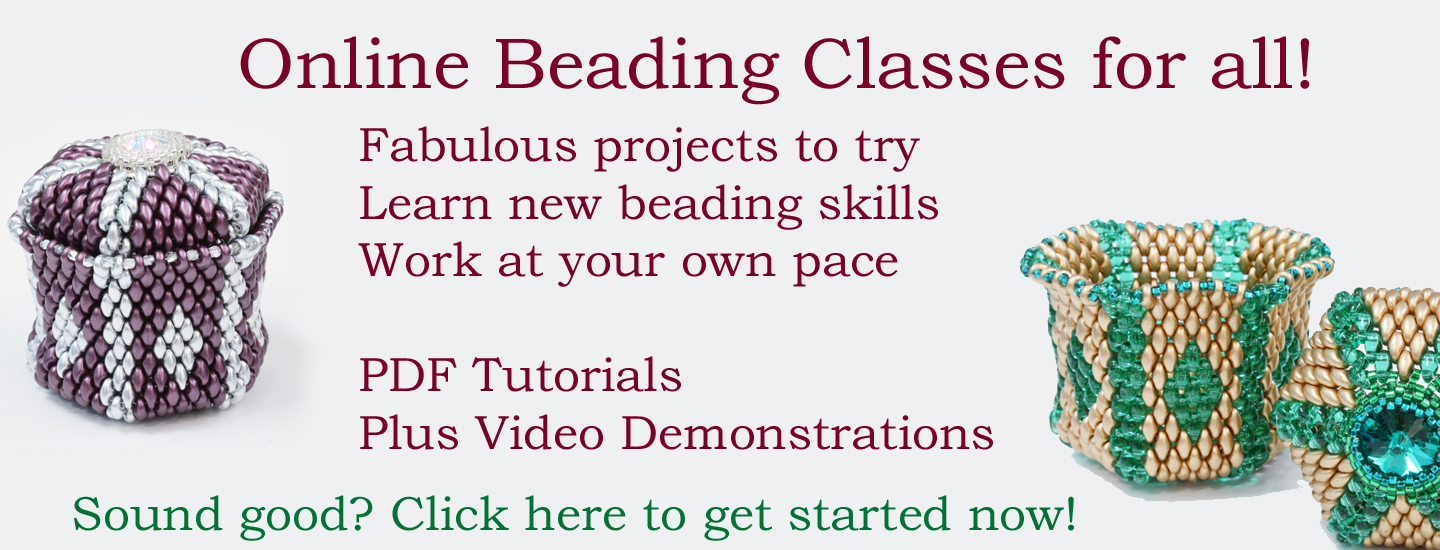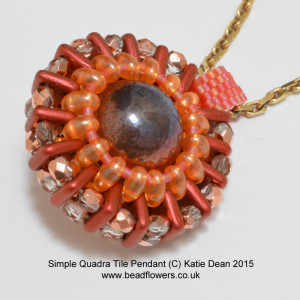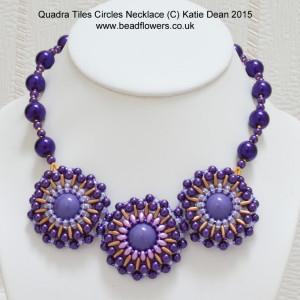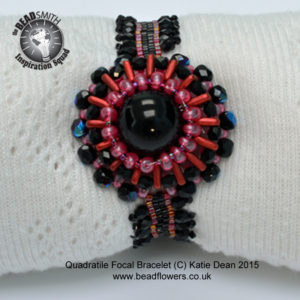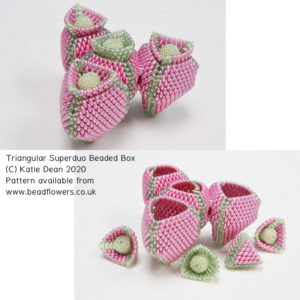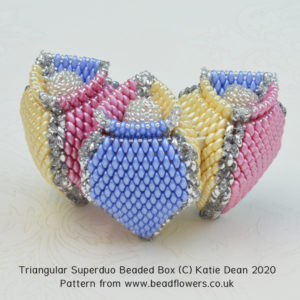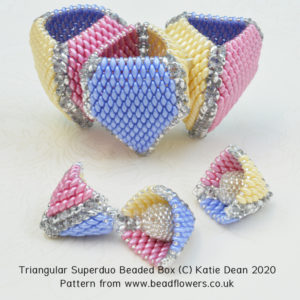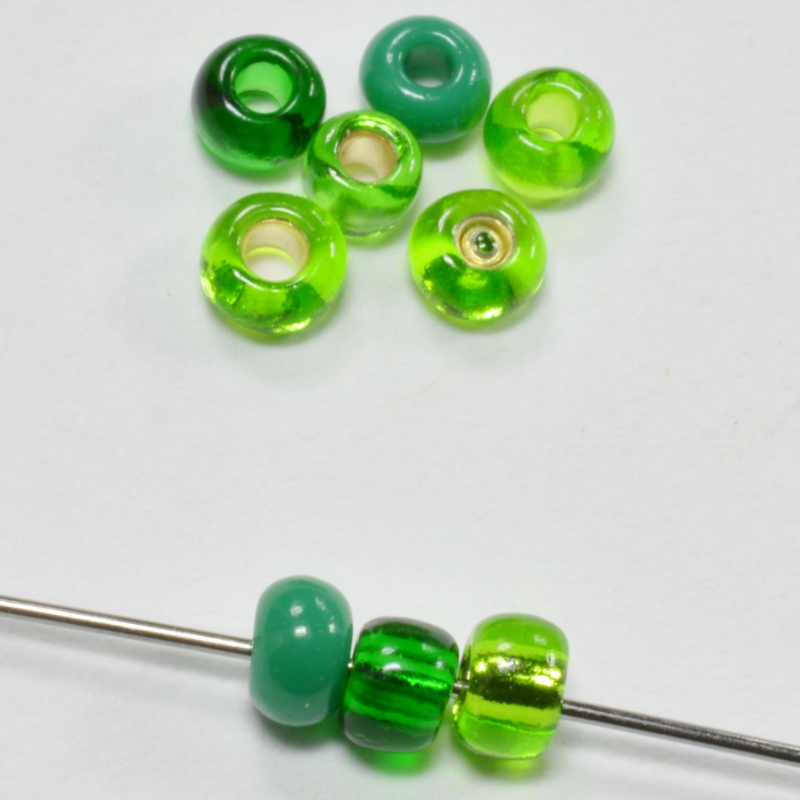Quadra Tile Beads
Quadra Tile beads fall under the very broad umbrella of ‘new shaped seed beads’. They were introduced to the market in 2014 by the Starman company. They are square in shape and quite thin. But they are characterised by the four holes through them. When I was trying explain this bead type to a student just by describing them, she suggested they sounded like buttons. This is not a bad way of thinking about them.
Quadra Tile beads fit into the seed bead category because of their small size. They measure about 6mm across and about 1mm in depth. So, they combine very well with the more traditional seed beads and delicas. They are available in a wide range of colours.
If you are not already familiar with the Starman brand, its developer, Nichole Starman, has put a lot of thought into the company’s bead offerings. They now have a great range of different shapes, including tile beads, bar beads, teardrops, tiny faceted beads and much more.
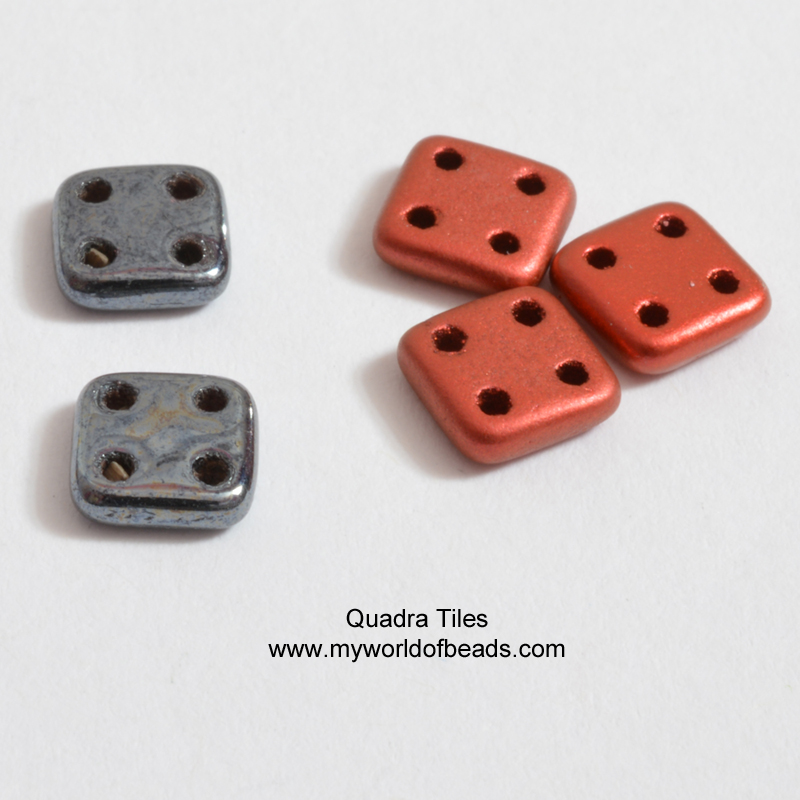 The whole range has been designed to fit together. So holes on the tile beads are spaced to match the spacing on the Quadra Tile beads and bar beads. From a design perspective this is brilliant as it means you can mix and match different shapes of beads, but not end up with uneven edges or finding that the beads will not lie well together. Everything fits together seamlessly and this opens up very exciting design possibilities.
The whole range has been designed to fit together. So holes on the tile beads are spaced to match the spacing on the Quadra Tile beads and bar beads. From a design perspective this is brilliant as it means you can mix and match different shapes of beads, but not end up with uneven edges or finding that the beads will not lie well together. Everything fits together seamlessly and this opens up very exciting design possibilities.
How do you design with Quadra Tile Beads?
Working with any new bead shape is very exciting. The Quadra Tile beads are no exception. The challenge lies in working out the design possibilities.
For me, the prospect of working with four holes was very exciting – it offers many different possibilities for linking and creating layers. I am still exploring all these different ideas. So, if you keep checking back I will update the pattern links as I find more and more ways of working with Quadra Tile beads.
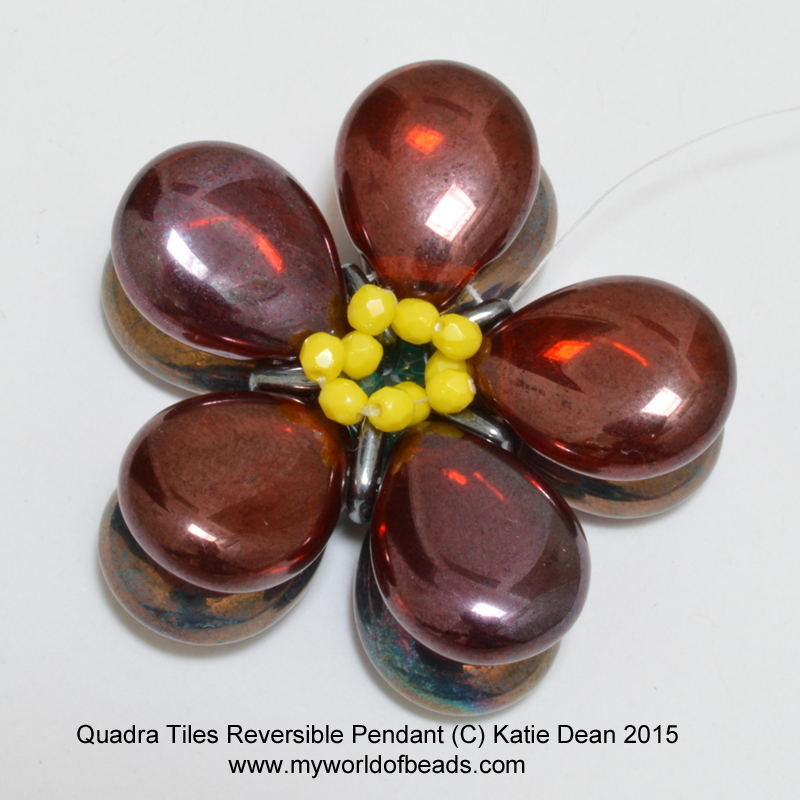 Firstly, let me turn to the idea of linking and layering. If you imagine the Quadra Tile stood upright on one of its sides, you then have four holes that can be used to link bead strands top, bottom, near and far.
Firstly, let me turn to the idea of linking and layering. If you imagine the Quadra Tile stood upright on one of its sides, you then have four holes that can be used to link bead strands top, bottom, near and far.
Linking components
I explored this idea in a very quick five minute project to create a reversible pendant. Using the two holes nearest to me, I created an inner circle using 2mm faceted beads to form a flower centre. I added an outer circle using teardrop shaped beads to form petals.
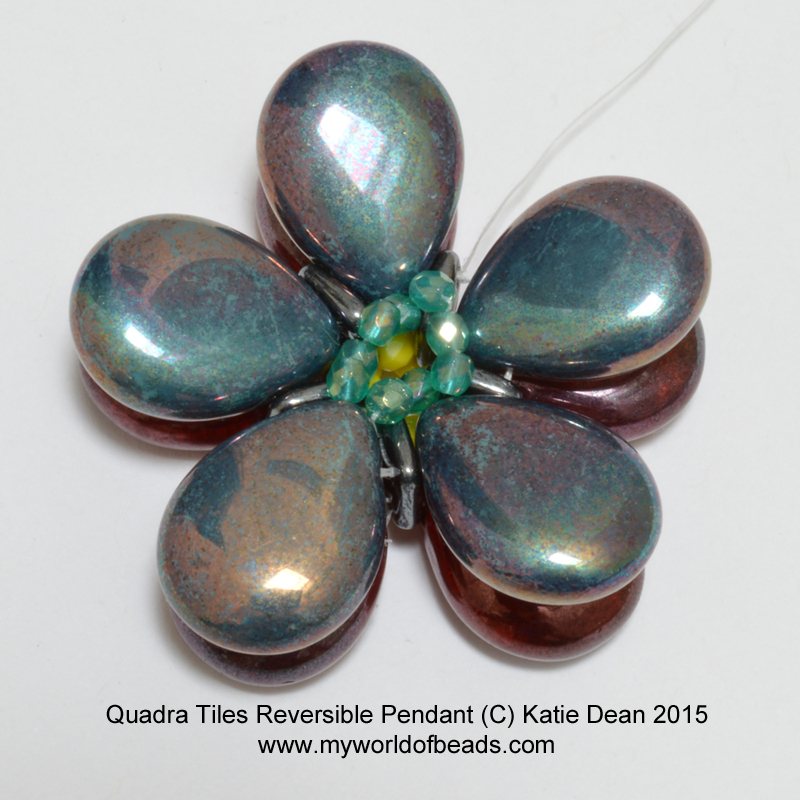 I then turned the Quadra Tile round so that these two circles of beads were furthest away from me, and repeated the process with the two free holes. By using two distinct colourways for the centres and the petals, I had a reversible pendant that could be worn with two outfits. I just needed to add a seed bead bail on the thread you can see in the photos.
I then turned the Quadra Tile round so that these two circles of beads were furthest away from me, and repeated the process with the two free holes. By using two distinct colourways for the centres and the petals, I had a reversible pendant that could be worn with two outfits. I just needed to add a seed bead bail on the thread you can see in the photos.
Embellishing
If you look closely at the photos, you can see that the narrow depth of the Quadra Tile beads means they are barely visible when they are used like this to link other beads. Given the lovely colour range and the interesting texture on the surface, this seemed a shame to me. So I have also been experimenting with ideas that use the Quadra Tile beads more for embellishment. Then, their whole front area is visible.
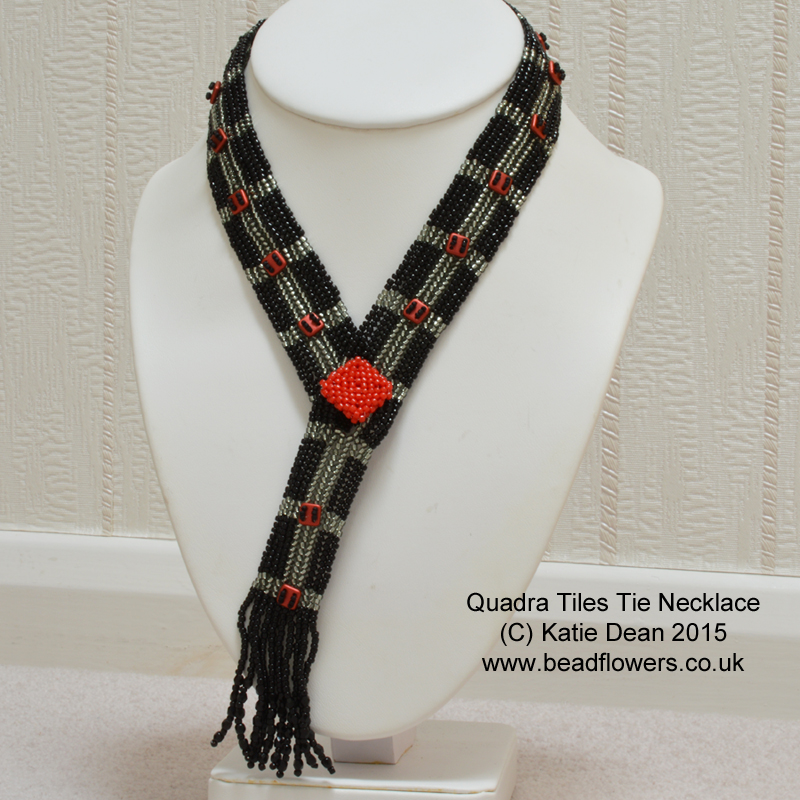
You can attach them to beadwork in this way just as you would sew a button onto a piece of clothing. Use tiny size 15 seed beads to cover your thread path, or leave it exposed if you prefer.
You can work ‘straight’ across the beads. So the thread path sides parallel with the sides of the beads. Or work on the diagonal. You can even just use a single bead to anchor each of the four holes in place. So, you have loads of ideas to try.
Tips for Working with Quadra Tile Beads
As with any seed bead, the main problem you are going to experience with Quadra Tile beads is blocked holes. If you are using traditional seed beads, this tends not to matter. You will stumble upon the blockage as soon as you try to use the bead. However, once you start introducing multiple holes into beads, you need to take great care.
Blocked holes
Often you will be using just one of the holes in your first row, then proceed on to the next hole in a later row. With two-holed beads, it can be frustrating enough if you haven’t checked your holes properly. The first hole may be fine, but you discover the blockage when you reach the second hole in the next row. You then have to un-do your work to replace the bead. Magnify this up to working with four holes and you can see how problematic this may be. 
So, however tedious it may seem, do check all four holes before you use every one of your Quadra Tile beads. Take a close look at the grey beads in the photo. The bottom left hole in each one looks like it may be blocked. These look like small scraps of glass that might push out with a bead reamer, but you would need to clear the holes properly before using the beads.
Wonky beads
The second common problem is mis-shapen beads. This is a very normal problem with beads. But the regular geometric shape of the Quadra Tile beads means that any mis-shapen beads will stick out in your work.
Personally I dislike throwing away beads. However, unless you are deliberately trying to create a ‘wonky’ design, you will certainly want to check your Quadra Tiles. I’m afraid the only solution is to throw out any that are not well shaped!
Where to Buy These Beads
It is very likely that your local bead store will carry Quadra Tiles. You can also purchase from a range of online stores. If you are looking for a recommendation, then this bead store is one that I use regularly and happily recommend.
Patterns using Quadra Tile beads
I will add some more links to this section of the blog as I find more patterns that use quadra tile beads in interesting ways. So do keep checking back here and do subscribe to the blog to make sure you keep up to date (there’s a handy form in the right hand side bar!).
Back to the patterns. If you want to experiment with creating layers using Quadra Tile beads, then this flower necklace is a very simple place to start. It may look complicated, but is in fact very easy. You can add your favourite type of chain as well. So, you can make that part as simple or fancy as you like.
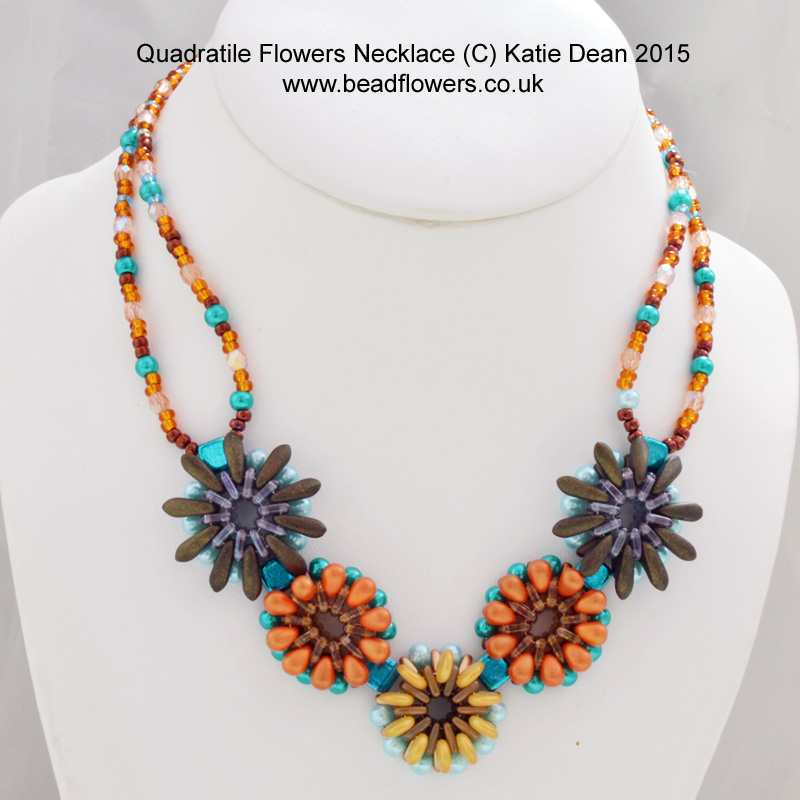
If you want to try using Quadra Tile beads for embellishment, then my QuadraTiles Tie necklace pattern is a very easy place to start. I took the inspiration from the idea of buttons. I’ve combined this with a simple herringbone base. So this is a fun project for any level.

Three projects, one idea!
I created the simple Quadra Tile pendant in under an hour when I needed a fast fix for a jewellery dilemma! This is a great pattern to start with if you want to work with some of the new shaped seed beads.
I developed this pattern after I had created the pendant. First, I turned it into a necklace, using a similar idea and combination of beads. You can find the Quadra Tile Beads Circles necklace here. The intricacy of the three circles at the front of the necklace is created by the Quadra Tiles. The necklace itself is simply strung with a beaded clasp at the back. It’s a great project for starting to use multiple-holed beads.
In a further development of the idea, I created a bracelet that goes with both the necklace and the pendant. I had been asked to teach a workshop. So, I thought this would make a great set of projects for the day. You can find the Dome Beads Bracelet Pattern here.
Beaded Boxes
I have also discovered that the Quadra Tiles are perfect for creating dimensional structures. So, in this triangular Superduo beaded box, I put them through their paces. As you can see, I’ve created two potential arrangements in this one design. But you can try out more. I can see many ways in which you can combine and arrange your boxes. So, click here if you would like the pattern.
What next?
I hope this has inspired you to try out this fascinating bead shape. From here, you can continue exploring My World of Beads to discover more beads to try. Or, why not sign up to the mailing list? You’ll get a free gift for joining. And I will send you a monthly email with all the latest beading news. So, you’ll never miss out on new beads, new techniques, design or business ideas, again! If that sounds good, then click here to join now. Wishing you happy beading!

